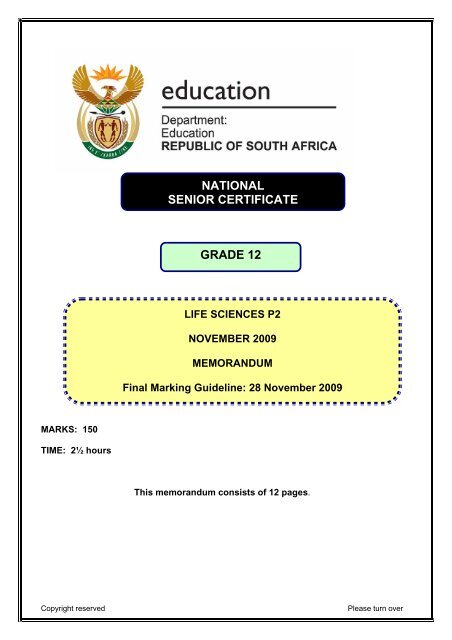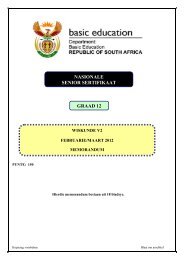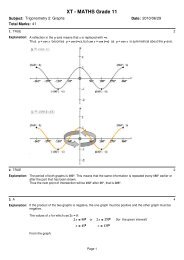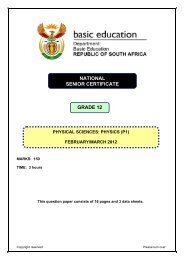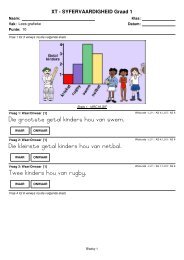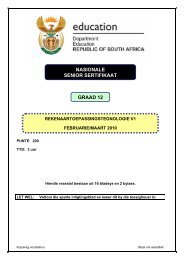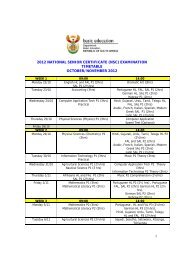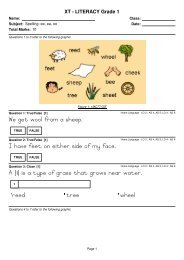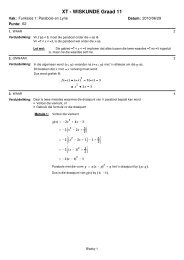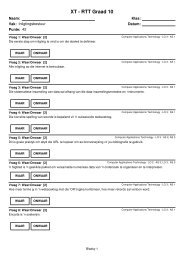LIFE SCIENCES Paper 2 Memo (Eng) November 2009
LIFE SCIENCES Paper 2 Memo (Eng) November 2009
LIFE SCIENCES Paper 2 Memo (Eng) November 2009
Create successful ePaper yourself
Turn your PDF publications into a flip-book with our unique Google optimized e-Paper software.
NATIONALSENIOR CERTIFICATEGRADE 12<strong>LIFE</strong> <strong>SCIENCES</strong> P2NOVEMBER <strong>2009</strong>MEMORANDUMFinal Marking Guideline: 28 <strong>November</strong> <strong>2009</strong>MARKS: 150TIME: 2½ hoursThis memorandum consists of 12 pages.Copyright reservedPlease turn over
PRINCIPLES RELATED TO MARKING <strong>LIFE</strong> <strong>SCIENCES</strong> <strong>2009</strong>1. If more information than marks allocated is givenStop marking when maximum marks is reached and put a wavy line and ‘max’ in theright hand margin.2. If, for example, three reasons are required and five are givenMark the first three irrespective of whether all or some are correct/incorrect.3. If whole process is given when only part of it is requiredRead all and credit relevant part.4. If comparisons are asked for and descriptions are givenAccept if differences / similarities are clear.5. If tabulation is required but paragraphs are givenCandidates will lose marks for not tabulating.6. If diagrams are given with annotations when descriptions are requiredCandidates will lose marks7. If flow charts are given instead of descriptionsCandidates will lose marks.8. If sequence is muddled and links do not make senseWhere sequence and links are correct, credit. Where sequence and links is incorrect,do not credit. If sequence and links becomes correct again, resume credit.9. Non-recognized abbreviationsAccept if first defined in answer. If not defined, do not credit the unrecognisedabbreviation but credit the rest of answer if correct.10. Wrong numberingIf answer fits into the correct sequence of questions but the wrong number is given, it isacceptable.11. If language used changes the intended meaningDo not accept.12. Spelling errorsIf recognizable accept provided it does not mean something else in Life Sciences or if itis out of context.13. If common names given in terminologyAccept provided it was accepted at the National memo discussion meeting.14. If only letter is asked for and only name is given (and vice versa)No credit15. If units are not given in measurementsCandidates will lose marks. <strong>Memo</strong>randum will allocate marks for units separatelyCopyright reserved
Life Sciences/P2 3 DoE/<strong>November</strong> <strong>2009</strong>NSC – <strong>Memo</strong>randum16. Be sensitive to the sense of an answer, which may be stated in a different way.17. CaptionAll illustrations (diagrams, graphs, tables, etc.) must have a caption18. Code-switching of official languages (terms and concepts)A single word or two that appears in any official language other than the learners’assessment language used to the greatest extent in his/her answers should be credited,if it is correct. A marker that is proficient in the relevant official language should beconsulted. This is applicable to all official languages.19. No changes must be made to the marking memoranda without consulting the ProvincialInternal Moderator who in turn will consult with the National Internal Moderator (and theExternal moderators where necessary)20. Only memoranda bearing the signatures of the National Internal Moderator and theUMALUSI moderators and distributed by the National Department of Education via theProvinces must be used.Copyright reservedPlease turn over
Life Sciences/P2 4 DoE/<strong>November</strong> <strong>2009</strong>NSC – <strong>Memo</strong>randumSECTION AQUESTION 11.1 1.1.11.1.21.1.31.1.41.1.5CBCCA (5 x 2) (10)1.2 1.2.1 (Scientific) theory1.2.2 Eutrophication1.2.3 (Bio)diversity1.2.4 Palaeontology 1.2.5 Alien/Exotic/Invasive (5)1.3 1.3.11.3.21.3.31.3.41.3.5NoneBoth A and B/A and B/BothB only/BA only/ABoth A and B/A and B/Both (5 x 2) (10)1.4 1.4.1 Domestic use (1)1.4.2 40,5 thousand tonsORDomestic waste -34,0(2)Industrial waste - 6,5 thousand tonsOR40 500 tons1.4.3 Between 1996and 1998 (2)1.4.4 Domestic use increases and industrial use increasesOR(Both) show an increaseORDomestic use is greater than industrial use (2)(7)1.5 1.5.1 Permian period (1)1.5.2 - The number of reptile species decreased- The number of mammal species increasedOR- In the beginning of the Cretaceous period the number of reptilespecies was large- but towards the end of the Cretaceous period the number ofreptile species decreased- In the beginning of the Cretaceous period the number ofmammal species was very small- but towards the end of the Cretaceous period the number ofmammal species started to increase (4)Copyright reservedPlease turn over
Life Sciences/P2 5 DoE/<strong>November</strong> <strong>2009</strong>NSC – <strong>Memo</strong>randum1.5.3 Reptiles, birds and mammals (3)1.5.4 Birds are more closely related to reptilesThey share a immediate/more recentcommon ancestor (3)(11)1.6 1.6.1 Accept any answer between 29 - 31arbitrary units (1)1.6.2 (a) The sulphur dioxide level was higher in 2000 compared to1995 in all countriesORThe sulphur dioxide level was lower in 2005 compared to 2000in most countriesORThe sulphur dioxide level was the same in most countries in2000 (1)(b) In France there was an increase in the level of sulphurdioxide from 2000 to 2005 whereas in all of the othercountries there was a decrease from 2000 to 2005 (2)1.6.3 Japan (1)1.6.4 • Using renewable sources of energy such as wind and solarenergy/reducing use of fossil fuels• Implementing programmes/strategies to save energy• Improved/alternative technology to reduce pollution• Improved legislation for air quality• Effective monitoring• Imposing heavy fines• Make use of public transport/bicycles/hybrid cars• Increased environmental awareness/education• (It only has 50 arbitrary units of sulphur dioxide) (Mark first TWO only) (any 2) (2)(7)[50]TOTAL SECTION A: [50]Copyright reservedPlease turn over
Life Sciences/P2 6 DoE/<strong>November</strong> <strong>2009</strong>NSC – <strong>Memo</strong>randumSECTION BQUESTION 22.1 2.1.1 Adaptation to eat different food/to different environmentalconditions/niches (adaptive radiation)ORDifferent beaks because of variation in the genotypesORMutationscauses variation in types of beak (2)2.1.2 During continental drift / physical separation of the islands fromthe mainlanda part of the original population became isolatedon the islandORThrough strong winds/ocean currents the birds may have beenblown/moved from the mainland to the islands (2)2.1.3- There is a great deal of variation amongst the finchessuch asdifferent shapes of beaks- On each island the finches lived under different environmentalconditions/ had different sources of food- The finches underwent natural selection- Only those finches that were better suitedto obtain the type of food available survived- Continued natural selection on each island over manygenerations - resulted in each island having species that were very different(genotypically and phenotypically) from each other- These differences prevented them from interbreedingleading to the formation of new species- This is termed allopatric speciation/adaptive radiation(any 7) (7)2.1.4 • More food available on the mainland• This decreases competition/decreases the effect of naturalselection in forming new species.OR• More diverse habitats on islands than on mainlandOR• Less diverse/more stable habitats on mainland than onislands (3)(14)Copyright reservedPlease turn over
Life Sciences/P2 7 DoE/<strong>November</strong> <strong>2009</strong>NSC – <strong>Memo</strong>randum2.2 2.2.1 - A large number of offspring is produced- There is a large amount of variation within a species- Of the large number of offspring only a small number survive- Characteristics are inheritable from parent to offspring - Animal breeders can selectively breed for certaincharacteristics(Mark first FOUR only) (any 4) (4)2.2.2LamarckDarwin1. Law of use and disuse 1. Law of natural selection2. The acquiredcharacteristics arepassed on to the next generation2. Inherent genetic characteristicscan be inherited from parents3. Organisms have an internal drive 3. Organisms do not have anto change/deterministicinternal drive to change/natureselects the best to survive4. Individuals change 4. Populations change5. Infers that no extinction becauseorganisms get better and betterand therefore survive5. Extinction occurs sinceorganisms may have features thatdo not favour survival (Mark first TWO only) any 2 x 2 + 1 table (5)2.3 2.3.1 They have the same index fossils (2)2.3.2 5 and 12 (2)(Mark first TWO only)2.3.3 Radiometric dating/ Relative dating/ Absolute dating/ Carbondating/ Isotope(carbon/uranium/potassium) dating/ Radio activedating(1)2.3.4 - Conditions for fossilisation to take place were not alwaysfavourable- All fossils NOT found yet- All organisms are not fossilised/some are eaten bypredators/some decay quickly- Incomplete fossils- Problems in identifying fossils(Mark first TWO only) any (2)(7)[30]Copyright reservedPlease turn over
Life Sciences/P2 8 DoE/<strong>November</strong> <strong>2009</strong>NSC – <strong>Memo</strong>randumQUESTION 33.1 3.1.1 Equal number of light and dark-banded snails will be eatenORMorelight-banded snails will be eatenORLesslight-banded snails will be eatenORMoredark-banded snails will be eatenORLess dark-banded snails will be eaten (3)3.1.2 Natural selection/camouflage/predation/survival of the fittest/micro-evolution (1)3.1.3 Light-banded OR Dark-banded(1)3.1.4 Lower number of lightbandedshells found,indicating that they are noteasily detected by thebirdsOR Higher number of darkbandedshells found,indicating that they are noteasilydetected/camouflaged by the birds(2)3.1.5 Started with equal numbers of light and dark-banded snailsin the environment (1)(8)3.2 3.2.1 - There was variation in the appearance of the whales- Whales probably evolved from a four-limbed terrestrialancestor- Some ancestral whales became aquatic- Whales with smaller hind limbs could swim well- and escape predators/find food in deeper water andfurther in the ocean- Those with larger hind limbs did not swim well and could notreach food/escape from predators- and therefore did not survive- Through natural selection, more whales with smaller hindlimbs survived- Over many generations whales with smaller and smallerhind limbs survived in greater numbers(any 5) (5)3.2.2 The genes are still present in the species (for the vestigialhind limbs)ORThe vestigial structure is no longer an advantage/disadvantageand therefore not selected for or against (2)(7)Copyright reservedPlease turn over
Life Sciences/P2 9 DoE/<strong>November</strong> <strong>2009</strong>NSC – <strong>Memo</strong>randum3.3 3.3.1 Aluminium10000 10 100 or x %95000 95 1= 10,5%Aluminium10000 10 100 or x %105000 105 1= 9,5%OR<strong>Paper</strong>3000 3 100 or x %7000 7 1= 42,8%<strong>Paper</strong>3000 3 100 or x %10000 10 1= 30%Aluminium uses a smaller percentage of energy (5)3.3.2 • Pollution/dumping is reduced since more scrap/materials willbe used• Less demand for land since fewer rubbish dumps would berequired• Cost effective/economical since decreased need for newraw materials/materials re-used• Creates jobssince more recycling plants will be established• Reduce exploitation of natural resources due to lowerdependence on raw materials 3 x 2 (6)(Mark first THREE only) (11)3.4 BiodegradablePollutants that can be broken downby organisms such as bacteria and fungie.g. any organic waste/faeces/vegetable matter, etc.Non-biodegradablePollutants that cannot be broken down by organisms such as bacteria andfungie.g. glass/plastic, etc.(4)[30]TOTAL SECTION B: 60Copyright reservedPlease turn over
Life Sciences/P2 10 DoE/<strong>November</strong> <strong>2009</strong>NSC – <strong>Memo</strong>randumSECTION CQUESTION 44.1 4.1.1 Volume of biogas produced (1)4.1.2 63/32 cm 3 (2)4.1.3 Use same amount of water in chicken manure and dried compostKeep all environmental conditions constantExtend the period of the investigationTake readings at shorter intervalsRepeat the investigation and find averagesInvestigation must be carried out jointly by John and NkosiNkosi and John must each do both experiments(Mark first TWO only) (2)4.1.4TypeTitle (Y)Volume of biogas produced per hour (cm 3 )18ScaleJoin CaptionKey or labellingof graphsVolume of biogas producedper hour (cm 3 )Rubric for the mark allocation 4 of the graph1614121086PlottingJoin Title (X)Correct type of graph 12Caption for graph 1Correct label for X-axis including unit 10Graphs labelled/key provided for 2 graphs 1Correct label for Y-axis including unit 1Appropriate scale for X-axis 0 1 2 3 4 15 6Appropriate scale for Y-axis 1Drawing of graphs1 – 1 to 2 points plotted correctlyTime ( 2 hours) – 3 to 5 points plotted correctly3 – 6 to 9 points plotted correctly4 – all 10 points plotted correctlyAll points joined for graph A 1All points joined for graph B 1Scale (X)NkosiJohn(13)(18)Copyright reservedPlease turn over
Life Sciences/P2 11 DoE/<strong>November</strong> <strong>2009</strong>NSC – <strong>Memo</strong>randumNOTE:If the wrong type of graph is drawn:- Marks will be lost for ‘correct type of graph’- Marks will be lost for ‘joining of points’If graphs are not drawn on the same system of axes:- Mark the first graph only using the given criteriaIf axes are transposed:- Marks will be lost for labelling of ‘X-axis’ and ‘Y-axis’4.2 4.2.1 Lives in shallow waterDoes not need expensive fishing equipmentEasy to removeSessile/don't move(Mark first TWO only) any (2)4.2.2 - Limit the number caught- Only licensed fishermen may catchperlemoen- Stipulate minimum size of perlemoen thatcan be caught- Impose seasonal limitations- Heavy penalties/fines for those whocontravene regulations- Declare as a protective species- Patrol all beaches where perlemoen isfound- Improve education/awareness- Encourage perlemoen farming/mariculture- Establish marine protected areas(Mark first TWO only)- Introducestrictlegislationany(2)4.2.3 The perlemoen is a herbivore/occupies the second trophic levelIf the number of perlemoen is reduced:Energy at the first trophic level /algae that the perlemoen feedson, will increasebecause of decreased demand for algae / food by perlemoen.There will also be a decrease in the energy at the third trophiclevel/ organisms feeding on perlemoenbecause of decrease in food supply (perlemoen) available tothem.The energy flow through the habitat will thus be reducedany (3)(7)Copyright reservedPlease turn over
Life Sciences/P2 12 DoE/<strong>November</strong> <strong>2009</strong>NSC – <strong>Memo</strong>randum4.3 Possible answerManagement strategies to improve the quality of water- Introduce legislation to control water pollution- Monitor emissions from industriesto ensure that legislation is beingfollowed- Impose heavy fines to discourage repeated acts of pollution- Provide incentives to companies to encourage them to reducepollution- Provide adequate sewage systems so that people do not urinate orpass faeces near a source of water- Provide clean containers to collect waterso that pollutants do notcontaminate the water- Use more organic fertilisers/less chemical fertilisers - so as to reducethe nutrient run-off into bodies of water- Educate people about the ill effects of pollution- Reduce the use of pesticides to decrease run-off into our rivers - Provide purified/safe water to everyone to reduce risk of them usingcontaminated water- Research new technologies to find more efficient methods ofpurificationmaximum 4x2 (8)Sources of water pollution- Sewage- Waste from factories- Dumping of rubbish/waste- Soap and chemicals entering the watermaximum (2)Effects on human physiology and health- Gastroënteritis- Cancer- Typhoid- Allergies- Cholera- Diarrhoea(Or any other relevant human disease of symptoms of disease)maximumContentASSESSING THE PRESENTATION OF THE ESSAY(2)(12)Marks3210DescriptionDiscussed all 3 aspects with no irrelevant informationDiscussed 2 or 3 aspects Or contains some irrelevant informationDiscussed 1 or 2 aspect Or contains much irrelevant informationNot attempted/nothing written other than question number/no correct informationSynthesis (3)(15)[40]GRAND TOTAL: 150Copyright reservedPlease turn over


